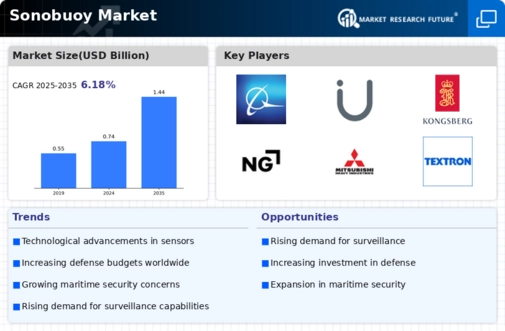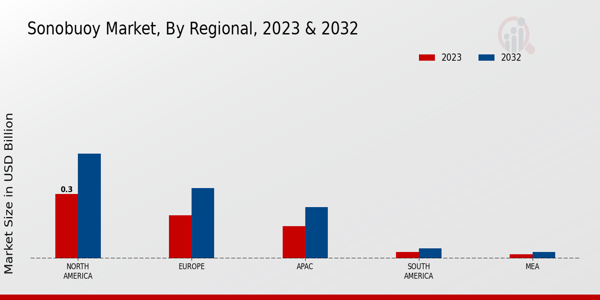Market Trends
Introduction
In 2023, the Sonobuoy Market is experiencing significant shifts driven by a confluence of macro factors including technological advancements, regulatory pressures, and evolving consumer behaviors. The rapid development of sophisticated sensor technologies and data analytics is enhancing the operational capabilities of sonobuoys, making them indispensable for modern maritime surveillance and anti-submarine warfare. Concurrently, increasing regulatory demands for maritime security and environmental protection are prompting stakeholders to innovate and adapt their offerings. Additionally, changing defense strategies and heightened geopolitical tensions are influencing procurement decisions, leading to a greater emphasis on advanced sonobuoy systems. Understanding these trends is crucial for stakeholders aiming to navigate the complexities of the market and capitalize on emerging opportunities.
Top Trends
-
Increased Demand for Anti-Submarine Warfare
The rising geopolitical tensions have led to an increased focus on anti-submarine warfare capabilities. For instance, the U.S. Navy has expanded its sonobuoy procurement to enhance maritime security. Reports indicate a 15% increase in sonobuoy orders from 2022 to 2023, reflecting the urgency in addressing submarine threats. This trend is likely to drive innovation in sonobuoy technology, leading to more advanced detection systems. -
Integration of AI and Machine Learning
The integration of AI and machine learning in sonobuoy systems is transforming data analysis and operational efficiency. Companies like Northrop Grumman are developing AI-driven algorithms to improve target recognition and tracking. This technological advancement is expected to reduce response times by up to 30%, enhancing mission effectiveness. Future developments may include fully autonomous sonobuoy systems capable of real-time decision-making. -
Miniaturization of Sonobuoy Technology
There is a growing trend towards miniaturization of sonobuoy systems, allowing for more versatile deployment options. For example, Boeing has introduced smaller, lightweight sonobuoys that can be deployed from various platforms. This shift is expected to increase operational flexibility and reduce costs associated with deployment. Future innovations may lead to even smaller units with enhanced capabilities. -
Enhanced Communication Capabilities
Advancements in communication technologies are improving the data transmission capabilities of sonobuoys. Companies like Thales Group are developing sonobuoys with advanced communication links that allow for real-time data sharing. This enhancement is crucial for coordinated operations among naval forces, potentially increasing mission success rates by 20%. Future developments may focus on secure, high-bandwidth communication systems. -
Sustainability and Eco-Friendly Designs
The push for sustainability is influencing the design and manufacturing of sonobuoys. Manufacturers are exploring eco-friendly materials and energy-efficient technologies to reduce environmental impact. For instance, Raytheon Technologies is investing in biodegradable components for their sonobuoys. This trend not only meets regulatory requirements but also appeals to environmentally conscious clients, shaping future product development. -
Collaboration with Defense Agencies
Increased collaboration between private companies and defense agencies is shaping the sonobuoy market. For example, partnerships between Ultra Electronics and various navies have led to tailored solutions that meet specific operational needs. Such collaborations are expected to enhance product relevance and effectiveness, driving innovation in the sector. Future partnerships may focus on joint research and development initiatives. -
Focus on Multi-Role Capabilities
There is a growing emphasis on developing multi-role sonobuoys that can perform various functions beyond anti-submarine warfare. Companies like L3Harris Technologies are designing versatile systems that can also support intelligence, surveillance, and reconnaissance missions. This trend is likely to expand the market for sonobuoys, appealing to a broader range of military applications. Future developments may include modular designs for easy upgrades. -
Increased Investment in R&D
Investment in research and development for sonobuoy technology is on the rise, driven by the need for advanced capabilities. Reports indicate that major players are increasing their R&D budgets by an average of 10% annually. This investment is expected to lead to breakthroughs in sensor technology and data processing. Future R&D efforts may focus on integrating emerging technologies such as quantum computing. -
Growing Use of Unmanned Systems
The integration of unmanned systems with sonobuoy technology is becoming more prevalent. For instance, Kongsberg Gruppen is developing unmanned underwater vehicles that deploy sonobuoys for enhanced surveillance. This trend is expected to improve operational efficiency and reduce risks to personnel. Future developments may see fully autonomous systems capable of conducting complex missions independently. -
Global Market Expansion
The sonobuoy market is witnessing global expansion, with emerging economies increasing their naval capabilities. Countries in Asia-Pacific and the Middle East are investing in sonobuoy systems to enhance maritime security. This trend is expected to diversify the customer base for manufacturers, leading to increased competition. Future market dynamics may shift as new players enter the sector, driving innovation and pricing strategies.
Conclusion: Navigating Sonobuoy Market Dynamics
The Sonobuoy market in 2023 is characterized by intense competitive dynamics and significant fragmentation, with both legacy and emerging players vying for market share. Regional trends indicate a growing emphasis on advanced capabilities, particularly in North America and Asia-Pacific, where technological advancements are driving demand. Legacy players are leveraging their established reputations and extensive distribution networks, while emerging companies are focusing on innovation, particularly in AI and automation, to differentiate themselves. As sustainability and flexibility become increasingly important, vendors must prioritize these capabilities to secure leadership positions. Strategic implications for decision-makers include the need to invest in R&D for next-generation technologies and to forge partnerships that enhance operational agility and environmental responsibility.












Leave a Comment